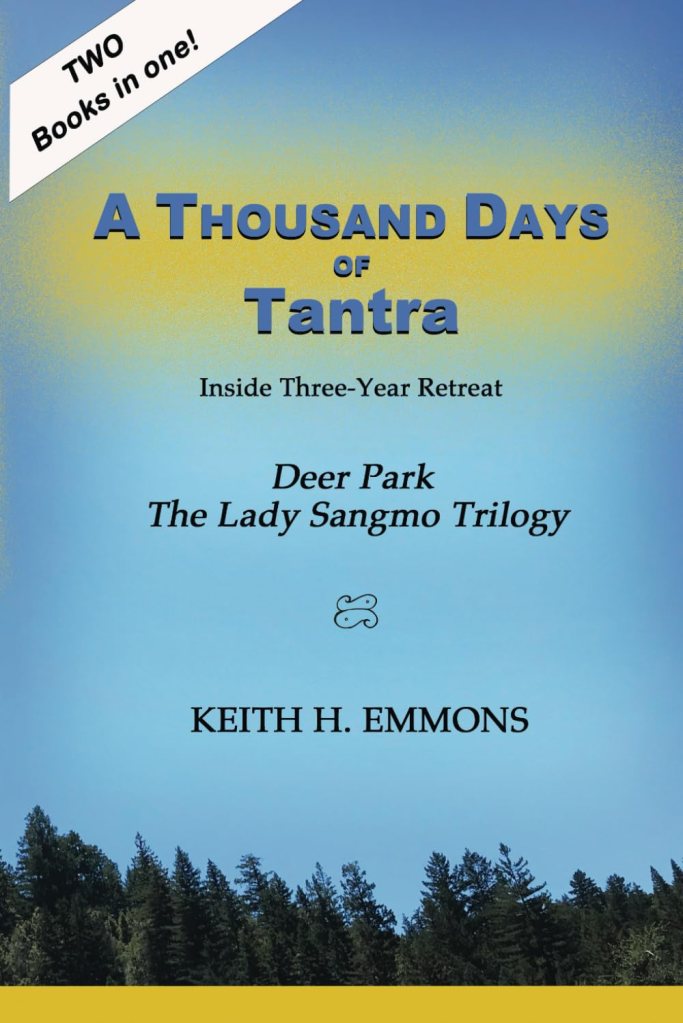I was introduced to Keith Emmons’ poetry last year when I met him through a mutual acquaintance. He shared a few poems with me and I instantly resonated with the way Keith captures the present moment with discernment. The initial poems I read reminded me a little of Jane Hirshfield’s poetry. When I learned that the poems came from poems written during a three year tantric retreat, I was instantly curious. Late last year, Emmons self-published these poems in his collection titled A Thousand Days of Tantra: Inside Three-Year Retreat. As he says, “The beauty of three-year retreat is expressed here in poetry” (p. 9).
The collection is made up of two books: Deer Park Poems and The Lady Sangmo Trilogy. Both collections present the first-hand experience of a three year, three month, and three day silent retreat conducted by Emmons and his tantric partner, herein named Lady Sangmo. The ‘thousand day” retreat is a central practice in Vajrayana Buddhism that involves intensive daily practice of Vajrayana methods like deity yoga, mantra recitation, and Mahamudra/Dzogchen, including focused study of Prajñāpāramitā or Perfection of Wisdom Sutras. Emmons and his committed partner added tantric practices to their retreat. As Emmons describes it, “A Thousand Days of Tantra is a unique presentation of an authentic long term retreat experience, conducted according to scripture, that is accessible and, hopefully, enticing to all” (p. 9).
Unique presentation indeed. Emmons writes in both free and rhyming verse, which is refreshing given the amount of free verse that seems to be preferred by contemporary poets. The images he creates are at once wistful and grounded in a reality reflective of a Buddhist worldview. And sometimes the poems are so intimate that they seem hardly appropriate of Buddhist poetry, until the reader remembers the tantric context, as if the only way to free oneself of desire is to relish in it.
What I appreciate most about Emmons’ poems is the way he transports the reader, bringing them along with him on retreat. Take for example this poem:
Day after day lifting the pink Post-it
and placing it at the next chapter -
as if going anywhere in a text
is going anywhere. Do the hills
go anywhere, verdant with giant redwoods
as mist advances up the valley
from the sea, cascades over the ridge
then silently recedes? Yellow beams
soften the haze, then diamonds sparkle
from moist bay leaves suspended in air.
I know each day something stays still;
each day something goes away (p. 34).
In the page before this poem the reader learns that Emmons is reading the Diamond Cutter Sutra (Vajracchedikā Prajñāpāramitā Sūtra) which is part of the Prajñāpāramitā. In the poem presented here, Emmons grapples with the notion of spiritual progress. Emmons creates friction by contrasting his experience of reading a Buddhist sacred text in a progressive linear fashion with terrain imagery that does not really “go anywhere”. The reader is brought up short on the path of the poem with the last two lines that resolve the tension between the text-based spiritual practice and the cyclical, fluid natural world by echoing a key teaching in the Diamond Cutter Sutra: ultimate reality is empty of inherent existence, and all phenomena are in constant flux (interdependent).
The seeming simplicity of the images and phases in this poem reflect all of Emmons’ collection. Perhaps a review that graces the back of the book and summarizes the collection will work best to entice readers to lose themselves in Emmons’ imagery: “I love especially the weaving of light and bird song, love making and wisdom texts, with turns of phrase and rhythm that startle and give strength over and over to your lines. You truly have made a pure land and sharing these echoes of it in this work is a great gift you are offering.” — written by Francesca Hampton, author of Buddha on a Midnight Sea and Leo Learns to Meditate.



